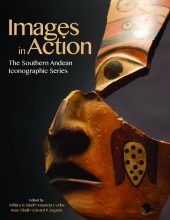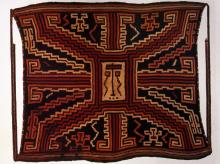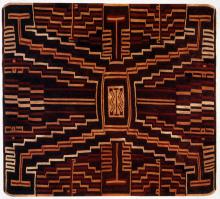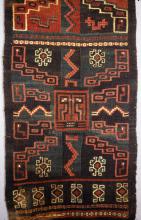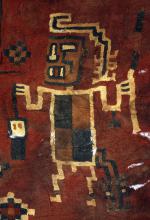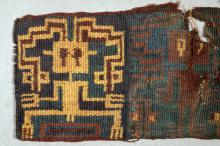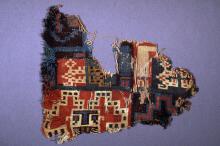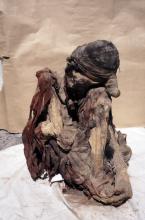Visual database
Siguas 1, roll-out drawings from bands of one engraved cane from a set of nine. The bands are 10.6, 9.8, and 9.1 cm in height, respectively. Note the horn-like appendage on the side of human heads, braided hair, and the two backward-looking animals. Both men and women had braided hair. Private collection. The dates of two engraved canes are available: cal. 206 to 1 BC (Haeberli 2002:Figure 1) and cal. 85 BC to AD 220 (one of the above set of nine, but not the illustrated one).
Siguas 1, Rayed Head Theme A, textile in discontinuous double interlocking warp and weft, both warp and weft in camelid fibers. A textile with similar iconography and a white background color was dated cal. 373 BC to AD 65. Private collection.
Siguas 1, Rayed Head Theme B, textile in discontinuous double interlocking warp and weft, both warp and weft in camelid fibers, dated cal. 206 BC to AD 116. Private collection.
Siguas 1, Rayed Head Theme C, textile in discontinuous double interlocking warp and weft, both warp and weft in camelid fibers, dated cal. 176 BC to AD 134. Private collection.
Siguas 1, Rayed Head, detail of a band fragment in interlocking tapestry, warp in cotton and weft in camelid fibers, dated cal. 359 BC to AD 1. Private collection.
Siguas 1, man with mythic attributes represented in the Staff God pose, detail of a narrow textile. Private collection.
Siguas 1, man with mythic attributes holding a staff and a severed head hanging from a cord, detail of a tunic in discontinuous double interlocking warp and weft, both in camelid fibers. Private collection.
Siguas 1, a crouching woman and a standing man (implied) with mythic attributes. Fragment of a band from the site of Santa Ana, Sihuas Valley, in interlocking tapestry; warp (5/cm) and weft (42/cm) in camelid fibers. The dark brown warp yarns are triplet. Private collection.
Siguas 1, four partial representations of a crouching woman with two felines between her legs. The women have no other feline characteristics than whiskers, possibly a mouthmask. Textile fragment from Panarcana, lower Ocoña Valley, in interlocking tapestry; warp in cotton (6/cm) and weft in camelid fibers (30/cm). Private collection.
Siguas 1, mummy, INC Arequipa, rescued by the archaeologist Marko López at the site of Santa Ana, Sihuas Valley, department of Arequipa. Note the horn-like appendage, in this case folded and tied braids wrapped in a head cover. The Siguas 1 tunic was dated cal. 392 to 160 BC.
